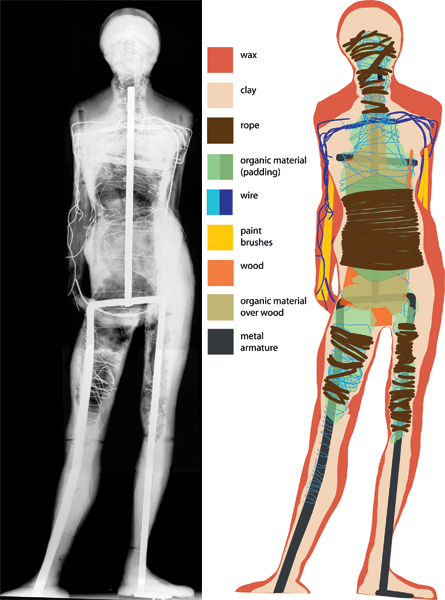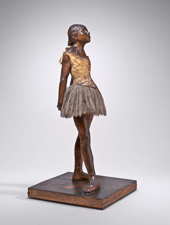Little Dancer Aged Fourteen
Technical Notes: Internal Construction
Technical Notes: Exterior Construction
Study in the Nude of Little Dancer Aged Fourteen (Nude Little Dancer)
Fourth Position Front, on the Left Leg
Technical Notes: Exterior Construction

Figs. 1–2
left: Degas, Little Dancer Aged Fourteen, radiograph, overall frontal view
right: Schematic diagram of the internal armature of Little Dancer Aged Fourteen. Illustration by Julia Sybalsky and Abigail Mack, 2007
Degas modeled on the exterior of the sculpture with molten beeswax, which was built up in layers over the clay cladding (see figs. 1, 2). Clusters of long parallel striations, representing successive campaigns of wax application, characterize the dancer’s contours. Varying in thickness from less than 0.5 centimeters at the ankles to approximately 4 centimeters on the shoulders, the wax medium was carefully selected for its malleable properties. Degas’ meticulous manipulation of the medium is beautifully recorded on the surface of this piece. For example, the dancer’s face includes very finely modeled features reinforced using a single-point tool and flesh carefully smoothed using a spatula. A single-point tool reinforced strands of hair in the dancer’s braid, while a spatula and point tool were used together to form the bangs across her forehead. On her arms, repeated diagonal broad-toothed tooling is present, particularly on the upper arm. Even the fourth and fifth digits of both hands, not readily visible, contain carefully rendered finger-nails outlined using a single point tool.
Degas created the illusion of fabric in some areas by tooling the wax. Creases in the dancer’s stockings at the knees are formed using single point tooling. In a similar way, the impression of gathered fabric is created in the wax on top of the feet. On the left shin, a line that resembles a seam extends down the dancer’s tights. Such an illusion is fortuitous, as the seam is created by the interior armature, coated with such a thin layer of wax that the contour of the pipe is recorded.
Microscopic samples taken from the head, hair, bodice, hands, right thigh, and slippers were found to contain beeswax, without added fats, extended with potato starch and pigmented primarily with red and yellow iron oxides, charcoal black, brown earth, calcium carbonate, quartz, lead white, chrome yellows, and chrome oranges.[1] Given the variety of pigments employed, many of which appear in Degas’ palette, it is likely that he toned the wax himself, seeking to simulate flesh tones — in some cases, such as the lips, applying a pink paint directly to the surface, and in other cases mixing pigment directly into the wax matrix.[2] Areas punctuated with unevenly mixed pigment, such as one on the right bicep, further support this explanation of Degas’s process. Writing in April 1881, the critic Charles Ephrussi rued the fact that, “had the work been more finished, the color of the wax would have been better blended, without those dirty blotches that spoil the overall appearance.”[3]
Notes
1. Barbara H. Berrie, Analysis Report, May 30, 2002, NGA conservation files; Michael Palmer, Analysis Report, March 29, April 17, 2002, NGA conservation files.; Suzanne Quillen Lomax, Analysis Report, January 4, 2004, NGA conservation files.
2. Barbara H. Berrie, Analysis Report, January 21, 2005, NGA conservation files, using XRF, identified the pink paint on the lips as vermilion. Many of the same pigments identified as colorants in the wax were found in Degas’ paintings and pastels. See David Bomford et al., Art in the Making: Degas, exh. cat. (London, 2004), for example, cat. 12.
3. Charles Ephrussi, "Exposition des artistes indépendants," La Chronique des Arts et de la Curiosité, April 16, 1881, 126: “On voudrait que l’exécution fût plus poussée, que la couleur de la cire fût mieux fondue dans ces plaques sales qui gâtent l’aspect général.” See also Paul Mantz, "Exposition des oeuvres des artistes indépendants," Le Temps, April 23, 1881.
